关于示波器,每个电子工程师都应该了解的几点
发布日期:2022-11-05
点击次数:1811
在电子工程师和技术人员要用到的全部测试设备中,最有用的无疑就是示波器。示波器的功能强大,可以帮助电子工程师和技术人员快速、准确地捕获随时间变化的电压(或电流等其他参数)测量值,而实验室中的任何其他设备都无法轻松完成这样的测量。
示波器是广泛用于制造业、电路设计等行业,对于故障排除,信号完整性以及简单了解电子电路工作原理的基本必备工具。
尽管现代的示波器的整个按键,旋钮,探针以及相关的探头配件和彩色显示屏看起来让人感觉很复杂, 令想要学习的人感到退缩。但实际上,千万不要让示波器的复杂外观吓到了,只要掌握一些基本的技巧,它是一种非常简单易用的设备。而且目前先进的示波器还会带有全触控功能,意味着所有的原始复杂的按键旋钮操作,都可以被触屏操作所取代。如果您经历过早期的按键手机和现在的智能手机,您就能很快理解触屏的优势。
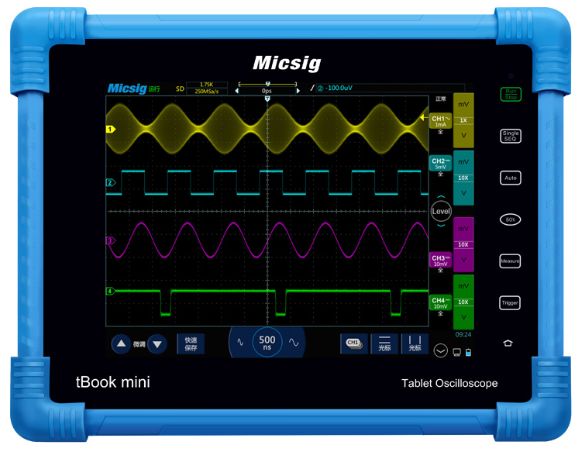

成为示波器行家的关键,首先是了解示波器的基础知识,然后再利用该基础知识去拓展学习。以下简短文将在这些方面介绍,一些新用户在示波器基本使用方面遇到的一些关键点和常见问题。这将帮助我们快速的了解示波器,找到正确的学习方向。随着学习时间的拉长,使用示波器到达一定时间后,我们几乎可以进行任何测量,最终在测试领域变得更加熟练和专业。
为简单起见,本文仅以麦科信STO1104C这款带全触控和安卓系统的智能示波器为例来介绍,对于老式传统的模拟示波器,随着时代的进步已经被明显的淘汰,也就不再复述。
接地与安全
在了解示波器的基础知识之前,我们先了解示波器适当的接地和安全性,以避免人身伤害以及损毁示波器或与示波器连接的任何配件。探头不正确的连接会形成电流通路,从而损坏探头。为避免电击,必须将示波器通过接地导线与大地相连。简而言之,探头金属部分连接到示波器是直接通过示波器的电源线与安全接地相连。
您可以使用欧姆表自己尝试更改连接。这是一种低阻抗连接方式,当被测电路也连接到大地时,就会形成一个环路,并且非常低的阻抗会导致电路中的电流过大。探头的接地导线的电流承载能力迅速超过其额定值,导线突然断开,您可能会听到一声巨响!
解决此问题的最佳方法是通过隔离被测电路或隔离示波器接地来断开接地环路。如果示波器的安全接地失效,最好的选择是确保被测电路未与地面安全接地相连。使用隔离示波器或差分探头,或选择使用隔离电源或电池为测试电路供电。使用USB连接器之类的东西给被测电路供电时要小心,因为这类设备通常不与地面隔离,并且仍然会遇到接地回路的问题。
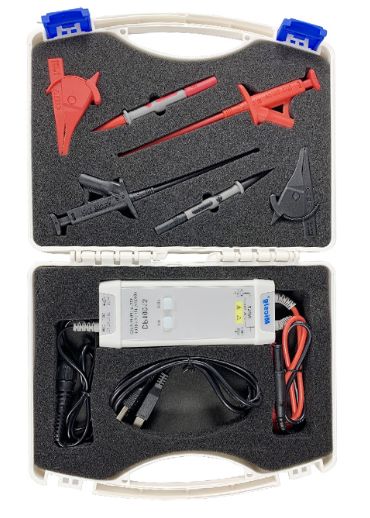 .
.
 .
.示波器是什么?
示波器可以通过电压传感器(即最常见的示波器电压探头)或某些其他传感器(例如压力传感器,电流探头,噪音计等)测量被测信号的电压波形。 示波器产生的的曲线图在垂直轴上测量的是电压,在水平轴上代表的是信号时间。 从捕获的波形中,我们可以获得诸如信号的频率,幅度,周期,相位,失真,噪声,DC,AC,占空比,上升/下降时间等数据。
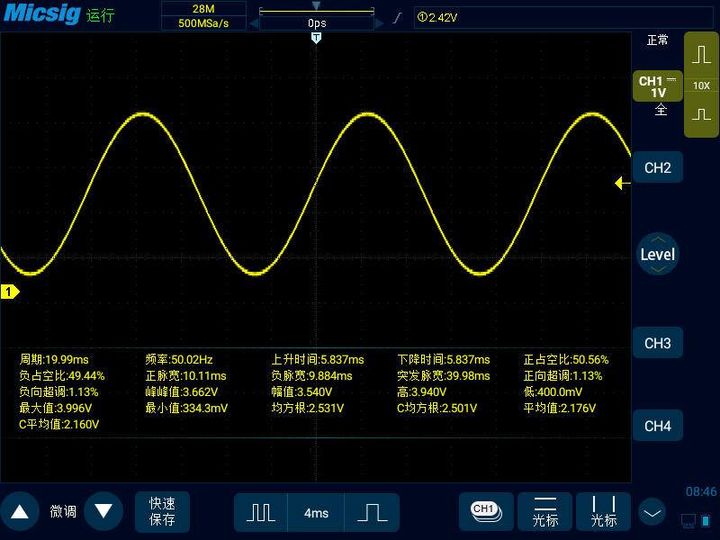

基础
除了显示屏外,还有其他三个重要的功能构成了示波器。 这些功能是示波器的触发,垂直方向上每格代表的伏特值,水平方向上每格代表的时间值。
触发
触发功能用于同步信号的水平扫描,这对于方便我们观察信号至关重要。 触发器通过重复显示输入信号的触发部分,使重复出现的波形在显示器上看起来静止不动。 示波器里最基本和常见的触发方式就是边沿触发。 这是大多数人首次开始使用示波器时最有可能使用的触发方式。 除此以外,示波器还有许多其他特殊的甚至复杂的触发方式用于响应特定的条件,并且真正可以使示波器成为功能强大的测量工具。 这些触发包括脉宽触发、逻辑触发,N边沿触发、欠幅触发、斜率触发、超时触发、视频触发、串行总线触发等。
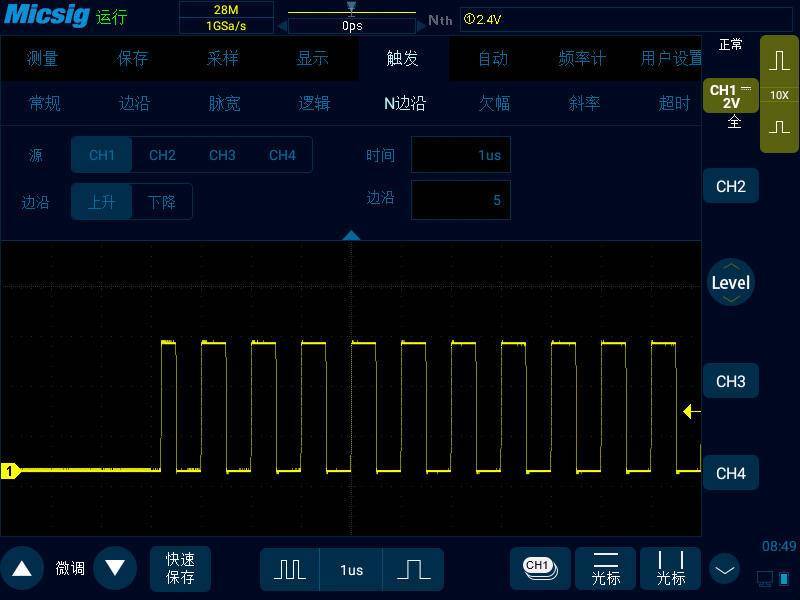

垂直档位(伏特/格)
通过调节示波器的垂直档位,可以放大和缩小波形在垂直方向上的形状。比如,如果我们将垂直档位设置为1V/格,而示波器垂直方向上有10格,那么示波器整屏幕最多可以显示10V的波形。需要注意的是,这个数值同样也和探头的衰减比有关,如果我们使用的是10X的探头,但是我们没有调节示波器通道的衰减比(默认为1X),那么正确的读数会和实际显示的读书相差10倍,因此在使用示波器的时候,也要注意探头的衰减比,要将通道的衰减比和探头的衰减比调成一致才可以。
输入耦合
输入耦合是示波器中另一种简单但普遍被忽略或误解的功能。它是指用于将电信号从一个电路连接到另一电路的连接方法,即从被测电路到示波器的连接方法。 您可以将输入耦合方式设置为直流耦合DC,交流耦合AC或接地耦合。 交流耦合仅阻止信号的直流部分通过,您会在显示屏上看到以零电平为中心的波形。 接地耦合会断开垂直控制的输入信号,从而让您看到显示屏上零电平的位置。 直流耦合设置允许显示所有输入信号,包括直流和交流。
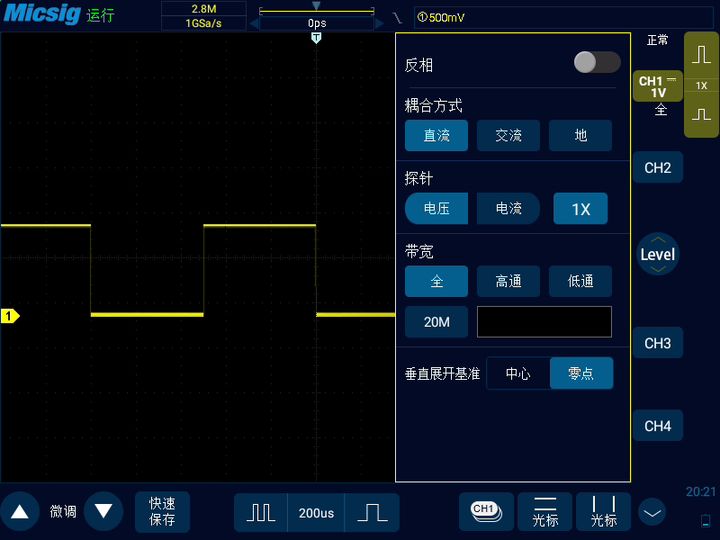

水平档位(时间/格)
水平档位功能也叫时基,可确定波形在显示屏上占有的时间。 与上述的垂直档位控制一样,水平档位控制也可以对波形进行缩放,相对于垂直档位控制的是波形的垂直方向,水平档位控制的是波形的水平方向。 如果时基设置为10ms,则显示屏上的水平方向上每个一格代表10ms,并且整个屏幕(假定显示屏上总共14个格)等于140ms,代表显示的整个波形是140ms时长,通过更改时基大小,可以轻松地观察输入信号的较长或较短的时间间隔。
性能
在对待信号快慢的态度上,大多数人一般只关心信号的频率,却不关心信号的上升时间。在标准的正弦波中,上升时间与频率是简单的数学关系,用于确定示波器带宽是否足够的典型公式为0.35除以上升时间。例如,需要测量上升时间为1ns的脉冲,这意味着示波器的最小带宽应在350MHz左右。但在实际中,傅立叶告诉我们,实际的波形是基波和高次谐波混合的产物。因此,波形的高次谐波比重越大,其上升时间越短。与信号的频率对比,上升时间更能代表信号的快慢。所以不要小看低频的信号,只要它的上升沿是在瞬间爆发的,则足以引起信号的振铃、反射、过冲等一系列问题。
采样率(Samples/second)和存储深度也是示波器的另一个重要考虑因素。采样率表示示波器每秒能采集数据点量的能力。采样率越高,示波器显示波形的真实性和细节就越高,关键信息丢失的可能性也就越小。如果要测量正弦波,一般的经验是示波器的采样率至少应为要测量的信号的最高频率分量的2.5倍。而如果测量方波,脉冲和其他信号类型,则采样率至少应为要测量的信号的最高频率分量的10倍。存储深度则代表示波器一屏幕最多可以保存多少个采样点。如果示波器的采样数据的能力足够,但是存储数据的能力不足,那么再大的采样率也是白费。就好比我们要倒一杯水喝,不管水壶开口多大,倒水的速度有多快,如果我们杯子太小,那始终也装不了多少水。采样率=存储深度÷波形记录时长,这就是这三者的关系。其中波形记录时长是我们控制的参数。其它2项一般都是固定参数(存储深度大的示波器也可以调节存储深度的大小,但是上限是固定的)。
探头
关于示波器的探头的知识,完全可以另起一篇文章也不为过。我们大多数人用的最多的探头,应该是1X或者10X衰减比的无源探头。使用探头时要注意探头能承受的最大峰峰值电压,防止被测电路的电容负载过大。测量高速信号,我们往往需要有源探头或者差分探头。
性价比
随着国产示波器的发展与崛起,示波器不再是普通电子爱好者的奢侈品,而是成了大多数人都能拥有一台的测试仪器。在示波器的中低端领域,现在的国产示波器的性价比已经完全吊打那些进口的示波器。所以,对于大多数人而言,购买一台国产的示波器是很不错的选择!
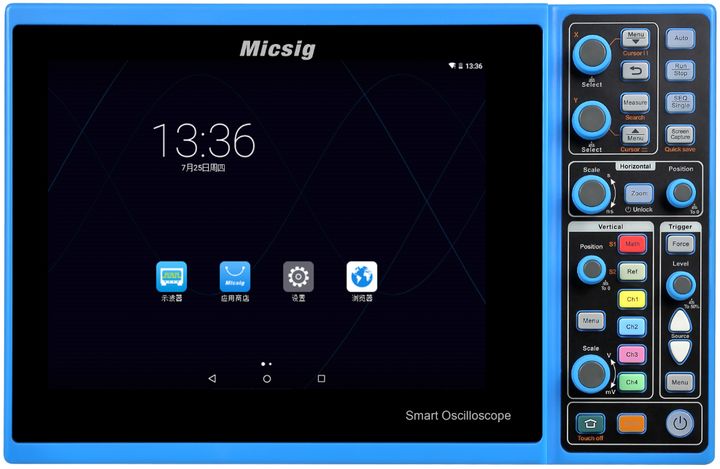

写在最后
示波器是产品开发和测试的主要仪器设备。 一开始它们也许看上去很复杂,但是实际上非常易于上手。 只要记住一些基本知识,多多使用她,您很快就会被认为是公司的示波器专家。随着电子器材系统繁杂度和工作频率的不断提高,需要用到示波器的应用场景也必然越来越多,考虑到示波器的长久使用寿命,早早的拥有和使用一台示波器是十分划算的。










